
Andy Lloyd's Dark Star Blog

Blog 68 (November 2018)
Has the Clovis Comet been Found?
Some 12,900 years ago, a sudden and significant change in the climate of our planet caused the destruction of a massive amount of fauna in the northern hemisphere (1). This event may have been the basis for the many Flood myths spoken of by so many ancient cultures around the world, including within the Bible (2). It has been suggested that this event may have been triggered by the impact of a substantial meteorite, which melted substantial sections of the prevalent Ice Sheets covering much of the northern hemisphere at that time. This immense melt would have resulted in raising ocean waters, and destructive tsunami covering much of the land not already under ice.
The main problem with this idea has always been the lack of a smoking gun in the form of an impact crater. If the meteorite had struck the ice sheet, then the crater could have been mostly carved into ice, which was then lost in later times when the climate warmed at the end of the last Ice Age. Now, it seems, there could be serious evidence of a major impact having occurred during the last Ice Epoch (3). It may have taken the form of what become known as the 'Clovis Comet', which is thought to have impacted at the point of the Younger-Dryas boundary condition.
Image credit: Kurt H. Kjæ et al.(3)
A 31 km wide, circular crater has been discovered under the Greenland
glacier, by researchers scouring over old NASA airborne radar data.
The crater-shaped depression in the bedrock lies beneath 1 km of ice.
The crater's size is suggestive of an object that was greater than 1 km
across.
The presence of the remains of this object have been implied from
sediment particles emerging from that area: "Glaciofluvial sediment from
the largest river draining the crater contains shocked quartz and other
impact-related grains. Geochemical analysis of this sediment indicates
that the impactor was a fractionated iron asteroid..." (3)
This, in turn, implies the presence below the Hiawatha Glacier of a
remaining chunk of solar system planetoid, perhaps a comet or asteroid,
which impacted during the Pleistocene era: "Although the crater is
completely covered by a region of ice called the Hiawatha Glacier, a
subsurface river draining from underneath is leaving tell-tale sediment
on the exposed land between the ice and the sea. Some of the
sediment particles have an internal structure that shows they were
subjected to a short-lived high-pressure shock wave, says Iain McDonald
of Cardiff University. “They’re absolutely characteristic of impact.”
They even hint at the composition of the meteorite. They contain metals
such as gold, nickel and cobalt, indicating the space object was a
relatively rare iron meteorite. These originate from the metal cores
inside planetoids, formed early in the history of the Solar System."
(4)
Worth digging out? That would be quite an ask, given the
kilometre-think sheet of glacial ice in the way. However,
searching the surrounding area for impact debris, in the form of small,
ejected meteorite fragments, could yield a better picture of the nature
of the impact, as well as narrowing down its age.
Written by Andy Lloyd, 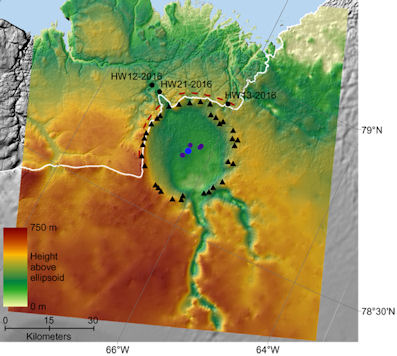
References:
1) R. B. Firestone et al. “Evidence for an extraterrestrial impact 12,900 years ago that contributed to the megafaunal extinctions and the Younger Dryas cooling”, PNAS, 104(41): pp16016–16021, (2007)
2) Andy Lloyd "Nibiru and the Younger Dryas Boundary" 26 May 2016,
andylloyd.org/darkstarblog38.htm
3) Kurt H. Kjæ et al. "A large impact crater beneath Hiawatha Glacier in northwest Greenland" Science Advances, 4(11), 14 Nov 2018,
4) Clare Wilson "Huge 30-kilometre wide meteorite crater found under Greenland glacier" 14 November 2018, with thanks to Peter
The Story of the Solar System Included a Missing Planet
A recently published astrophysical annual review has appraised our current knowledge of the formation of the solar system, and how it came to look the way it does now, warts and all (1). The evidence suggests that the major gas and ice giant planets did not form where they currently are, but that they underwent patterns of migration which, over time, carved the solar system into its current structure. These migratory patterns were triggered by periods of instability in the solar system, largely resulting from the gravitational changes caused by the dissipation (and accretion) of the pre-solar disc of dust rotating around the Sun. This model is known as the Nice model.
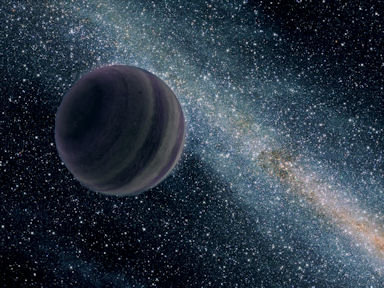
However, computer simulations based upon this model struggle to truly account for the complexities of the current solar system structure, that is until another massive planet is added into the initial mix:
"The best scenario — the one that reproduced a solar system that most closely resembles the real one — was one with an extra planet that lived between the original orbits of Saturn and Uranus. The world was roughly as massive as Uranus and Neptune, or about 16 times as massive as Earth. It was this planet that could have gotten tangled with Jupiter’s orbit and been tossed out of the solar system." (2)
This planet was ejected into interstellar space. It may have become the now famously sought-after Planet Nine, still hanging around in the distant depths of the solar system far beyond the Kuiper belt (3).
The annual review article also addresses the timing of the late, heavy bombardment - a seeming massive spike of catastrophic impacts with kicked off some 4.1 billion years ago, some time after the solar system seems to have settled down after its initial formation. Reading through this section (1), it seems that the author argues that the late, heavy bombardment was triggered early on, and that the effect we can see on the lunar surface was part of an on-going process. In other words, the dating of the cataclysm may have much to do with the formation of the lunar crust, which hides the record of impacts prior to 4.1 billion years. This seems to be the implication. This seems to be a fudge, if my reading of this is correct. Instead, the lateness of the late, heavy bombardment seems to be an anachronism which does not sit well with the earlier migratory movements attested to in the Nice model.
The computer simulations all work on the basis of what is contained within the solar system. Yet, it is also recognised that the ejection of worlds from early solar systems is littering interstellar space. In which case, it is not too much of a reach to argue that a rogue, missing planet may have made an incursion into the solar system from beyond, triggering the late, heavy bombardment. Our solar system, after all, is not a closed, isolated unit. Instead, it floats in what appears to be an increasingly complex galactic medium.
Written by Andy Lloyd,
31st October 2018
References:
1) David Nesvorný "Dynamical Evolution of the Early Solar System", Annual Review of Astronomy and Astrophysics, Vol. 56: pp137-174
2) Christopher Crockett "Lost world: An ancient ninth planet that went missing", 3 October 2018 with thanks to Lee
3) K. Batygin & M. Brown "Evidence for a Distant Giant Planet in the Solar System" 20 January 2016, The Astronomical Journal, Volume 151, Number 2,
Two Oceans Worth of Water Infused into the Earth
The Earth should be a dried out husk of a world. Yet, despite the blasting of solar radiation it received when in it unshielded, primordial state, it has retained, or gained, copious amounts of volatile water. How? For a long time, scientists pointed to comets, with their supposed 'dirty snowball' compositions, as the culprits. Early impacts (of which there were many) delivered the required water to a desiccated Earth. Except that the comets aren't all that wet, it turns out. The water they do have doesn't really match that of the Earth's either. Scientists can compare the isotopic composition of water: the ratio of regular hydrogen atoms (H) to “heavy” hydrogen (also called deuterium, or D), known as the D/H ratio.
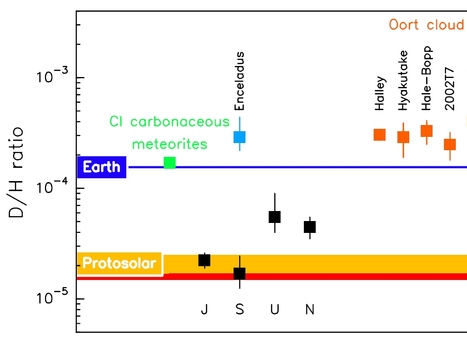
Image credit: ESA (1)
The D/H ratio
of water in Earth’s global ocean is about 150 parts per million (ppm). In comparison, water in a range of comets varies from 150 ppm to 300 ppm. In comparison, the D/H ratio of water in asteroids is about 140 ppm, which represents a much better fit with the water on Earth. This has led to increased speculation that earth received its water from asteroids, rather than comets. Unfortunately, things aren't that straightforward. Where an object forms with the solar nebula and emerging protoplanetary disk could have an impact upon this ratio. But so could the gravitational force holding onto the lightest element, hydrogen, which, with oxygen, combines to make water. Because deuterium is twice as heavy as its simplet cousin, hydrogen, it won't be driven away so easily. So, the more volatiles are driven away from a given planet or planetoid, the greater the D/H ratio fo what's left behind.To illustrate, Jupiter and Saturn can hang on to hydrogen really well, providing a source of water when combined with oxygen. The D/H of hydrogen in the solar nebula is very low compared to Earth, asteroids or comets: 21 ppm . This is in keeping with the gas giants. because their gravitational powers enable them to hold onto primordial hydrogen, the D/H ratio is maintained at levels close to the solar nebula these behemoths formed out of. by contrast, small bodies, like asteroids, don't have anywhere near that pulling power, and their volatiles are likely to be driven off (as can be visibly seen in the case of comets as they approach the warmth of the Sun from deep space).
The terrestrial planets, as well as the ice giants, lie somewhere in between. Could the Earth have held on to some of this solar nebula hydrogen early on? To investigate this tidea, a team from Arizona State University’s (ASU) School of Earth and Space Exploration (SESE) conducted computer simulations to try to work out whether Earth rocks, deep within its mantle, could have incorporated hydrogen early on, which could then combine with oxygen to produce an abundance of sub-surface water.
"The hydrogen that wafted to early Earth may have gone through a series of geochemical processes that greatly raised the amount of heavy hydrogen it contained, resulting in the D/H ratio we see today. If so, it could have been another source of Earth’s water. The team found, based on dissolved hydrogen, that the Earth hides about two oceans’ worth of water in its mantle and about four to five in its core. About one out of every 100 water molecules on Earth came from the solar nebula, they estimate. Much of the rest comes from asteroids, and some from comets." (2)
To be honest, 1% doesn't seem all that impressive. But there may be more solar nebula-sourced hydrogen yet buried in the planetary core:
"We ...consider it likely that several oceans’worth of hydrogen, perhaps the majority of hydrogen, resides in thecore, sequestered there as hydrogen in the mantle partitioned into metal blebs that then sank to the core.If this process were not accounted for, the total hydrogen content of Earth could be underestimated." (3)
'ingassing' of volatiles into the early Earth from the solar nebula could therefore provide a potential source of water, despite the driving forces trying to rid the Earth of this early, lightly bound material. But, as ever, this is all rather convoluted. A simpler solution, which seems to be almost universally ignored as a possibility, is that the Earth formed beyond the snowline of the solar system, and migrated inwards to its current position, already laden with its water. This would readily explain the evident similarities between the D/H ratios of Earth and chondrites from asteroids.
Written by Andy Lloyd,
15th November 2018
References:
1) ESA "Deuterium to Hydrogen Ratio in the Solar System" 5 October 2011
2) Chelsea Gohd "Some of Earth’s Water Came From A Stream of Hydrogen Long Ago, Scientists Say" 9 November 2018, with thanks to Bruce
3) Jun Wu et al. "Origin of Earth's Water: Chondritic Inheritance Plus Nebular Ingassing and Storage of Hydrogen in the Core" 9 October 2018
onlinelibrary.wiley.com document
Barnard's Star's Super-Earth
Barnard's Star
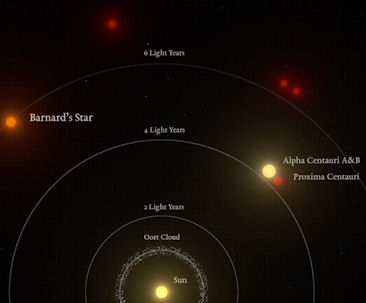
Image credit: IEEC/Science-Wave - Guillem Ramisa
Yet, despite the challenges of its relative dimness, and it's rapid in-coming motion, diligent astronomers, who have studied this star's behaviour for two decades, think that they have detected a Super-Earth planet orbiting around it (1). If the periodic wobbles in the red dwarf's motion do indeed point to the gravitational influence of an orbiting Super-Earth (2), then the newly discovered planet, or Barnard's Star b, is the second nearest known exoplanet to Earth. The periodic wobble implies an orbital period of 233 days, and mass of just over 3 Earth masses. There may even be an other planet lurking in the backwoods:
"The candidate planet around Barnard’s star is a cold super-Earth, with a minimum mass of 3.2 times that of Earth, orbiting near its snow line (the minimum distance from the star at which volatile compounds could condense). The combination of all radial-velocity datasets spanning 20 years of measurements additionally reveals a long-term modulation that could arise from a stellar magnetic-activity cycle or from a more distant planetary object." (3)
This frigid Super-Earth object, which lies beyond Barnard's Star's snowline, would join a group of planets which are turning out to be the most frequently encountered category of exoplanet. Yet, we have no examples of such a world in our own solar system - unless you include the proposed Planet Nine...
Written by Andy Lloyd,
15th November 2018References:
1) ESO 1837 "Super-Earth Orbiting Barnard’s Star" 14 November 2018
2) Nadia Drake "Potential super-Earth found nearby after decades-long hunt" 14 November 2018
nationalgeographic.com article
3) I. Ribas et al. "A candidate super-Earth planet orbiting near the snow line of Barnard’s star" Nature, 563: pp365–368, 15 November 2018,
'Oumuamua '10x More Reflective than Comets'
That odd interstellar object that whizzed around the Sun last autumn is continuing to cause major headaches for astronomers. Its hyperbolic trajectory is flinging it away from the Sun so quickly that any chance of studying it in more detail has been lost. Recently, astronomers have tried to point the powerful Spitzer telescope towards it, with little success. The fact that Spitzer couldn't observe it provided an upper limit to 'Oumuamua's size (1), although this size is very much dependent upon its shape. It seems that that shape is highly elongated, complicating the size issue considerably. Still, this retreating object is self-evidently not 'warm', otherwise Spitzer would have had better chances to spotting it.
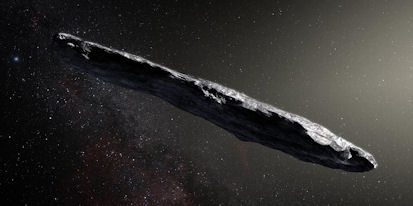
Image credit: European Southern Observatory / M. Kornmesser
NASA's report about these new scientific findings [which are in press (2)] indicate that the object is much brighter than expected. It is 10x more reflective than normal comets:
"The new study also suggests that 'Oumuamua may be up to 10 times more reflective than the comets that reside in our solar system — a surprising result, according to the paper's authors." (1)
In a
different, recent paper published in the Astrophysical Journal Letters, Harvard professors Shmuel Bialy and Abraham Loeb have proposed several theories to explain ‘Oumuamua’s strange behaviour (3). This includes the possibility that this visiting object is artificial, a topic which Abraham Loeb was quite comfortable about discussing during a BBC radio interview (4). The high albedo of this object may make that seem even more likely.The problem with this object is that its changing trajectory indicates that it's out-gassing, like a comet, but at the same time it is not visibly out-gassing. So, it looks like an interstellar asteroid, but moves like a comet. That may suggest that it is making use of some kind of propulsion. At the very least, it's not behaving in a 'normal' way. Regrettably, it is now too far away from us, and too small, for astronomers to collect more data about this fascinating object. As such, the nature of 'Oumuamua is likely to become somewhat legendary.
In my forthcoming new book, 'Darker Stars', I have set out a great deal of what we know, and what we don't know, about this bizarre object.
Written by Andy Lloyd, 15th November 2018
References
:1
) Calla Cofield "NASA Learns More About Interstellar Visitor 'Oumuamua" 14 November 2018,2) David E. Trilling et al. "Spitzer Observations of Interstellar Object 1I/'Oumuamua", The Astronomical Journal , 156(6): 261, 14 November 2018
3) Shmuel Bialy & Abraham Loeb "Could Solar Radiation Pressure Explain 'Oumuamua's Peculiar Acceleration?" The Astrophysical Journal Letters, 12 November 2018
4) BBC World Service "Could this asteroid be an extraterrestrial probe?" 5 November 2018,
New Theory about Atlantis
A great many locations have been proposed for the vanished civilisation of Atlantis, as described by the great Greek philosopher Plato in his book Timaeus, c. 360BCE.. The legendary island of Atlantis was located beyond the 'Pillars of Hercules' (i.e. the Straits of Gibraltar), in the Atlantic Ocean, and disappeared beneath the waves about 9000 BCE. Notable speculations about the location of this mysterious island include: the Greek volcanic island of Santorini; an archipelago of submerged islands just west of Gibraltar (1), Bimini in the Caribbean, and even a civilisation buried under the Antarctic ice-sheet (2).
A new suggestion has been recently set out in the U.K. newspaper, the Daily Mail. A British team of researchers believe that they have found a compelling trail of evidence suggestive of Atlantis. The location? In the Parque Nacional de Doñana in Spain, north-west of the Strait of Gibraltar, and just north of the port of Cadiz (3). The argument goes that this area was once a large inland sea, peppered with islands which sank as a result of tsunamis. Archaeological remains in the area have been attributed to the Romans and Greeks, but the researchers at the Yorkshire-based satellite imaging firm Merlin Burrows think that they pre-date these ancient civilisations by at least hundreds, and possibly thousands of years.
Image credit: Ingenio Films/Magnus News Agency
The team has presented evidence of materials science at the site far in advance of what the Romans and Greeks were know to have routinely made use of:
"Maritime historian Tim Akers, head of research at Merlin Burrows, said not only had they discovered Atlantis, but also found the people were incredibly advanced. He said 'laboratory analysis' of material recovered from Spain showed evidence of a type of cement not seen before, as well as ancient advanced metallurgy. A greenish blue patina has been found covering some of the ruins which tests have shown is an ancient combination of metals.
"He said: 'Plato describes in detail a patina on the buildings and structures of the cities and temples making up this complex. We have filmed clear evidence and have collected samples which have been scientifically tested in a lab in Modena, Italy, which is used to test ancient Roman finds. The results of the tests prove the age of the finds are older than Roman or Greek, and that they were more advanced.'" (3)
The use of the term 'Atlantis' triggers fascination and ridicule in equal measure. Homer's city of Troy, as described in the Iliad, was once considered mythical. But we now know that the city existed, at Hisarlik in Anatolia, Turkey. Today, it is a UNESCO World Heritage site. Perhaps, one day, a similar attribution will be made for the mythical sunken civilisation of Atlantis.
Written by Andy Lloyd, 1
7th November 2018References:
1
) Jon Copley "Sea level study reveals Atlantis candidate" 19 September 20012) Rand Flem-Ath and Colin Wilson "The Atlantis Blueprint: Unlocking the Ancient Mysteries of a Long-Lost Civilization" 2000, Warner Books
3) Harry Pettit "Could this be Atlantis? Ancient ruins flooded off the Spanish coast are the lost city declare UK satellite experts" 15 November 2018, with thanks to Peter and Mattia
4) UNESCO "Archaeological Site of Troy"

You can keep informed of updates by following me on Twitter:
![]()
Or like my Facebook Page: https://www.facebook.com/darkstarandylloyd